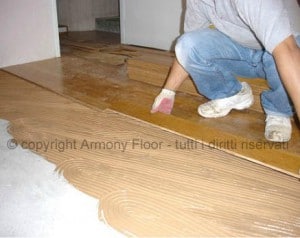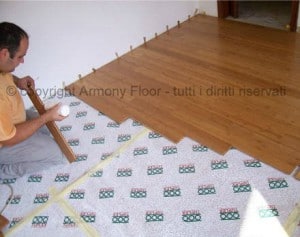Wood Flooring laying
Parquet installation: glued, nailed, floating
In laying parquet , the main types of installation of the wooden floor are: glued laying, nailed laying and floating laying (also called floating laying) .
The various types of installation are shown below, reminding you that in the purchase of Armony Floor parquet, upon request, installation is not included.
Parquet installation glued
 There glued installation it is performed by spreading the glue on the substrate, taking care to apply a little adhesive also on the heads of the elements, leaving the long sides free to carry out the normal settling movements. The sides of the elements must absolutely not be glued to allow, during the stabilization phase, the regularization of any shrinkage and to avoid cracks.
There glued installation it is performed by spreading the glue on the substrate, taking care to apply a little adhesive also on the heads of the elements, leaving the long sides free to carry out the normal settling movements. The sides of the elements must absolutely not be glued to allow, during the stabilization phase, the regularization of any shrinkage and to avoid cracks.
The vinyl glue in aqueous dispersion (better the one with a low water content) can be used on all substrates as long as they are absorbent and for the lamparquet 10 mm (strip) and industrial 14-22 mm format. The two-component dry-residue polyurethane glue must be used for all other formats (10 and 14 mm thick plank, 5-22 mm plank) and for all parquet when there are non-absorbent substrates (marble, ceramic, grit).
Nailed parquet installation
There nailed pose is performed by foreseeing the drowning in the caldana dei joists of fir (or other conifers) with trapezoidal section, of variable length and with a thickness of at least 2 cm. The joists are normally arranged in parallel and equidistant rows, oriented orthogonally or obliquely to the direction of laying the floor. The distance between the joists will be between 20 and 30 cm and the nailing takes place at 45 ° on the male element generally using two nails per plank.
Laying floating or floating parquet
 There floating laying (hence the term floating parquet or floating parquet, which has the same meaning) is used for the installation of solid and three-layer flooring with tongue and groove or click. It is suitable for any type of substrate and in particular when you want to place the new floor without removing the existing one. The elements are laid on perfectly flat surfaces and on an acoustic insulating mat. The planks are joined together at the joints with dots of vinyl glue or “dry” by means of accessories (clips) or special coupling mechanisms (clicks).
There floating laying (hence the term floating parquet or floating parquet, which has the same meaning) is used for the installation of solid and three-layer flooring with tongue and groove or click. It is suitable for any type of substrate and in particular when you want to place the new floor without removing the existing one. The elements are laid on perfectly flat surfaces and on an acoustic insulating mat. The planks are joined together at the joints with dots of vinyl glue or “dry” by means of accessories (clips) or special coupling mechanisms (clicks).
Checks before laying the parquet:
– the windows with glass as well as the main entrance doors have been installed;
– the painting of the rooms has been carried out;
– the testing of the plumbing, electrical and floor heating systems have already been carried out;
– the vapor barrier has been placed between the substrate and the caldana while on the ground floor a welded bituminous sheath has been placed between the slab and the pipes of the plumbing and electrical systems and is positioned “in a bowl” for 5 cm above the finished floor plan;
– the ambient humidity is between 45% and 65% and the temperature in the rooms is not lower than 100 (in the winter period, activate the heating 10 days before starting to lay the parquet);
– the humidity of the substrates does not exceed 2% by weight for normal or quick-drying cementitious screeds, 1.7% for heated screeds and 0.5% for anhydrite screeds. The measure to tion must be performed using a carbide hygrometer;
– the screed is well leveled without excessive undulations, is free from cracks or cracks and is sufficiently rigid, hard and compact;
– the screed is clean of lime, paint, oil and other encrustations;
– the drying of single-layer wood is between 7% and 11% humidity (a wood with excessive drying, is very greedy for water is in contact with it, it swells abnormally to the point of undergoing “bending” so exaggerated as to overcome the cohesive force of even the best glue) .
The operations following the gluing and / or nailing of the parquet
There roughing: it is the first and most important of the operations, since the final result of the installation depends on its effectiveness and precision. It is used to remove any unevenness between the elements that make up the floor and is carried out with ab r to s therein coarse-grained.
There sanding : it is the intermediate operation that serves to eliminate the irregularities produced by the previous phase and is carried out with abrasiv the medium grain.
There grouting : it is the operation that is used to eliminate the cracks that are almost always present between the elements of a parquet, through the application of a wood dust paste.
There sanding: is the last operation aimed at obtaining a perfectly flat surface, free from imperfections and stucco residues and ready to receive paint, wax, oil.
There painting : varnish parquet finishing is a fairly recent process that has almost completely replaced the previous wax or oil finishing treatments, even if the latter t rova n or today more and more use.
The varnishing has positively solved the problem of maintenance and maintenance of the parquet, technically improving the wooden surface and giving the floor the following characteristics:
– greater hardness and resistance to abrasion and surface scratches,
– greater protection and impermeability to wood,
– enhancement of the grain and color of the wood species.





